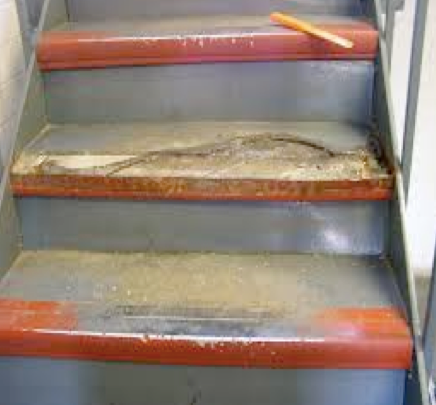Spot The Safety Violation: Watch Your Step(s)!
What could happen to workers’or anyone’who tries to walk up or down these stairs’

Slips and trips are common safety incidents in many workplaces. In fact, CCOHS says that, in Canada, over 42,000 workers get hurt each year due to falls’about 17% of the time-loss injuries that were accepted by workers’ comp boards across Canada.
Stairways can be a particularly dangerous place for a worker to slip or trip and fall. A common tripping hazard in a stairwell is worn, uneven or broken stair coverings, including lumpy carpeting, ripped and raised linoleum, or rubber stair treads that are starting to lift.
The stairs in this picture pose serious tripping hazards to anyone trying to navigate them. First, the treads are worn and the covering on the step in the middle is completely torn apart. A worker going up or down that step could easily catch his foot and fall.
In addition, it’s unsafe to leave tools, materials or other objects laying on stairs, such as what appears to be a shim or piece of wood on the top step. Such materials can also cause workers to trip and tumble down the stairs.
In addition to the hazards depicted in this picture, there are other factors that can contribute to a nasty fall on the stairs, including:
- Burned out lighting or weak illumination of stairwells
- Rickety or unstable handrails
- Water or other spilled liquids
- Ice or mud that has been tracked onto stairs.
7 AREAS TO ADDRESS TO MAKE STAIRS SAFE
Here are seven areas to address to prevent slips, trips and falls on stairways:
1. Housekeeping. Keep the stairwells clean and clear of obstacles. Use cleaning methods and equipment that are suitable for the surface being treated. (See, Housekeeping Requirements under the OHS Laws.)
2. Lighting. Ensure adequate lighting levels, positioning lights so the entire stairway is evenly lit and all potential hazards and obstructions can be clearly seen.
3. Inspections. Stairs should be regularly inspected for damage and maintenance carried out when necessary. (Use this slips, trips and falls inspection checklist.)
4. Stairways. Handrails, slip-resistant covers on steps and high visibility and non-slip markings on the front edges of steps can all help to prevent slips and trips on stairs.
5. Spills. Clean up spills immediately using an appropriate cleaning method. Use warning signs where stairs are wet and arrange alternative routes.
6. Obstructions. When possible, remove them. If that’s not possible, then use suitable barriers and warning notices.
7. Footwear. Workers should wear suitable footwear, such as those with slip-resistant soles.